Extending Satellite Predictions of Coral Disease Outbreak Risk to Non-Seasonal Coral Reef Regions
Abstract
1. Introduction
2. Materials and Methods
2.1. Development of Percentile-Based Thresholds in the Great Barrier Reef
2.2. Application of the Percentile-Based Methodology to Seasonal and Non-Seasonal Regions
- Calculating rolling averages: A 91-day (i.e., 3-month) rolling average SST time-series was generated with each value assigned to the centre of the 91-day window. This smoothing technique was used to identify the broad shape of cold and hot periods in SST and to filter high-frequency variability. As there were no data for late-1984 in CoralTemp (to contribute to the initial 45 days of the rolling average calculation in January and February 1985), for the purpose of calculating the 91-day average in early-1985, the last 45 days of the year 1985 were used as a proxy for the last 45 days of the year 1984.
- Determining the coldest and hottest months: The number of days was counted for each calendar month during which the smoothed SST was equal to or below the percentile value corresponding to the winter AV during 1985–2005. Similarly, the days during which the smoothed SST was equal to or exceeded the percentile threshold corresponding to the summer AV were counted for 1985–2005. The month with the greatest counts (i.e., highest occurrence frequency) for each was designated as the coldest and hottest month, respectively. The start months of the three-month coldest and hottest periods were set to be one month prior to the designated coldest and hottest months, respectively.
- Setting the reset time: The definition for when accumulations are reset to zero each year was chosen in the same way as the existing seasonal method: three months prior to the start of the three-month hottest period for the Hot Snap metric; and two months prior to the start of the coldest period for the Cold Snap and Winter Condition metrics.
2.3. Comparison of the Percentile-Based Metrics with Coral Disease Data in the Howland and Baker Islands and Guam
2.3.1. Howland Island and Baker Island
2.3.2. Guam
3. Results
3.1. Development of Percentile-Based Thresholds in the Great Barrier Reef
3.2. Application of the Percentile-Based Methodology to Seasonal and Non-Seasonal Regions
3.3. Comparison of the Percentile-Based Metrics with Coral Disease Data in Howland and Baker Islands and Guam
4. Discussion
4.1. Comparing Methodologies for Thresholds and Metrics
4.2. Application of the Percentile-Based Methodology to Seasonal and Non-Seasonal Regions
4.2.1. The Effect of Percentile-Based Thresholds and Reset Months on the Metrics
4.2.2. New Percentile-Based Metrics and Literature Reports on Coral Disease
4.3. Comparison of the Percentile-Based Metrics with Coral Disease Data in Howland and Baker Islands and Guam
5. Conclusions
Supplementary Materials
Author Contributions
Funding
Data Availability Statement
Acknowledgments
Conflicts of Interest
References
- Reef Resilience Network. Coral Disease. Available online: https://reefresilience.org/management-strategies/managing-local-threats/managing-coral-disease/#:~:text=Coral%20disease%20outbreaks%20are%20a,soft%20corals%20over%20extensive%20areas (accessed on 22 October 2023).
- Harvell, D.; Jordán-Dahlgren, E.; Merkel, S.; Rosenberg, E.; Raymundo, L.; Smith, G.; Weil, E.; Willis, B. Coral Disease, Environmental Drivers, and the Balance between Coral and Microbial Associates. Oceanography 2007, 20, 172–195. [Google Scholar] [CrossRef]
- Raymundo, L.J.; Couch, C.S.; Harvell, C.D. Coral Disease Handbook: Guidelines for Assessment, Monitoring & Management; Coral Reef Targeted Research and Capacity Building for Management Program: Brisbane, Australia, 2008. [Google Scholar]
- Tracy, A.M.; Pielmeier, M.L.; Yoshioka, R.M.; Heron, S.F.; Drew Harvell, C. Increases and decreases in marine disease reports in an era of global change. Proc. R. Soc. B Biol. Sci. 2019, 286, 20191718. [Google Scholar] [CrossRef] [PubMed]
- Heron, S.F.; Willis, B.L.; Skirving, W.J.; Mark Eakin, C.; Page, C.A.; Miller, I.R. Summer Hot Snaps and Winter Conditions: Modelling White Syndrome Outbreaks on Great Barrier Reef Corals. PLoS ONE 2010, 5, e12210. [Google Scholar] [CrossRef] [PubMed]
- Aeby, G.S.; Bourne, D.G.; Wilson, B.; Work, T.M. Coral Diversity and the Severity of Disease Outbreaks: A Cross-Regional Comparison of Acropora White Syndrome in a Species-Rich Region (American Samoa) with a Species-Poor Region (Northwestern Hawaiian Islands). J. Mar. Biol. 2011, 2011, 490198. [Google Scholar] [CrossRef]
- Bruno, J.F.; Selig, E.R.; Casey, K.S.; Page, C.A.; Willis, B.L.; Harvell, C.D.; Sweatman, H.; Melendy, A.M. Thermal Stress and Coral Cover as Drivers of Coral Disease Outbreaks. PLoS Biol. 2007, 5, 1220–1227. [Google Scholar] [CrossRef] [PubMed]
- Caldwell, J.M.; Heron, S.F.; Mark Eakin, C.; Donahue, M.J. Satellite SST-Based Coral Disease Outbreak Predictions for the Hawaiian Archipelago. Remote Sens. 2016, 8, 93. [Google Scholar] [CrossRef] [PubMed]
- Ferreira, B.P.; Costa, M.B.S.F.; Coxey, M.S.; Gaspar, A.L.B.; Veleda, D.; Araujo, M. The effects of sea surface temperature anomalies on oceanic coral reef systems in the southwestern tropical Atlantic. Coral Reefs 2013, 32, 441–454. [Google Scholar] [CrossRef]
- Greene, A.; Donahue, M.J.; Caldwell, J.M.; Heron, S.F.; Geiger, E.; Raymundo, L.J. Coral Disease Time Series Highlight Size-Dependent Risk and Other Drivers of White Syndrome in a Multi-Species Model. Front. Mar. Sci. 2020, 7, 601469. [Google Scholar] [CrossRef]
- Harvell, D.; Altizer, S.; Harrington, L.; Weil, E. Climate change and wildlife diseases: When does the host matter the most? Ecology 2009, 90, 912–920. [Google Scholar] [CrossRef] [PubMed]
- Maynard, J.A.; Anthony, K.R.N.; Harvell, C.D.; Burgman, M.A.; Beeden, R.; Sweatman, H.; Heron, S.F.; Lamb, J.B.; Willis, B.L. Predicting outbreaks of a climate-driven coral disease in the Great Barrier Reef. Coral Reefs 2011, 30, 485–495. [Google Scholar] [CrossRef]
- Miller, A.W.; Richardson, L.L. Emerging coral diseases: A temperature-driven process? Mar. Ecol. Mar. Ecol. 2015, 36, 278–291. [Google Scholar] [CrossRef]
- Randall, C.J.; Van Woesik, R. Contemporary white-band disease in Caribbean corals driven by climate change. Nat. Clim. Chang. 2015, 5, 375–379. [Google Scholar] [CrossRef]
- Ruiz-Moreno, D.; Willis, B.L.; Page, A.C.; Weil, E.; Cróquer, A.; Vargas-Angel, B.; Jordan-Garza, A.G.; Jordán-Dahlgren, E.; Raymundo, L.; Harvell, C.D. Global coral disease prevalence associated with sea temperature anomalies and local factors. Dis. Aquat. Org. 2012, 100, 249–261. [Google Scholar] [CrossRef] [PubMed]
- Sato, Y.; Bourne, D.G.; Willis, B.L. Dynamics of seasonal outbreaks of black band disease in an assemblage of Montipora species at Pelorus Island (Great Barrier Reef, Australia). Proc. R. Soc. B Biol. Sci. 2009, 276, 2795–2803. [Google Scholar] [CrossRef] [PubMed]
- Vega Thurber, R.; Mydlarz, L.D.; Brandt, M.; Harvell, D.; Weil, E.; Raymundo, L.; Willis, B.L.; Langevin, S.; Tracy, A.M.; Littman, R.; et al. Deciphering Coral Disease Dynamics: Integrating Host, Microbiome, and the Changing Environment. Front. Ecol. Evol. 2020, 8, 575927. [Google Scholar] [CrossRef]
- Zvuloni, A.; Artzy-Randrup, Y.; Katriel, G.; Loya, Y.; Stone, L. Modeling the Impact of White-Plague Coral Disease in Climate Change Scenarios. PLoS Comput. Biol. 2015, 11, e1004151. [Google Scholar] [CrossRef] [PubMed]
- Langlais, C.E.; Lenton, A.; Heron, S.F.; Evenhuis, C.; Sen Gupta, A.; Brown, J.N.; Kuchinke, M. Coral bleaching pathways under the control of regional temperature variability. Nat. Clim. Chang. 2017, 7, 839–844. [Google Scholar] [CrossRef]
- Mahlstein, I.; Spirig, C.; Liniger, M.A.; Appenzeller, C. Estimating daily climatologies for climate indices derived from climate model data and observations. J. Geophys. Res. 2015, 120, 2808–2818. [Google Scholar] [CrossRef]
- Skirving, W.; Marsh, B.; De La Cour, J.; Liu, G.; Harris, A.; Maturi, E.; Geiger, E.; Mark Eakin, C. CoralTemp and the Coral Reef Watch Coral Bleaching Heat Stress Product Suite Version 3.1. Remote Sens. 2020, 12, 3856. [Google Scholar] [CrossRef]
- NOAA Coral Reef Watch. Daily Global 5 km Satellite Coral Bleaching Heat Stress Monitoring. Available online: https://coralreefwatch.noaa.gov/product/5km/index.php (accessed on 21 September 2023).
- Heron, S.F.; Heron, M.L.; Pichel, W.G. Thermal and Radar Overview. In Coral Reef Remote Sensing; Springer: Dordrecht, The Netherlands, 2013; pp. 285–312. [Google Scholar]
- Coral Disease and Health Consortium. White Syndromes of the Western Atlantic. Available online: https://cdhc.noaa.gov/coral-disease/characterized-diseases/white-syndromes-of-the-western-atlantic/#:~:text=%E2%80%9CWhite%20Syndromes%E2%80%9D%20are%20a%20collection,coral%20diseases%20throughout%20the%20world (accessed on 23 October 2023).
- Coral Reef Information System. NOAA’s National Coral Reef Monitoring Program. Available online: https://www.coris.noaa.gov/monitoring/ (accessed on 2 October 2023).
- Middleton, J.H.; Buchwald, V.T.; Huthnance, J.M. The anomalous tides near Broad Sound. Cont. Shelf Res. 1984, 3, 359–381. [Google Scholar] [CrossRef]
- Weeks, S.J.; Bakun, A.; Steinberg, C.R.; Brinkman, R.; Hoegh-Guldberg, O. Capricorn Eddy: A prominent driver of the ecology and future of the southern Great Barrier Reef. Coral Reefs 2010, 29, 975–985. [Google Scholar] [CrossRef]
- Brinkman, R.; Wolanski, E.; Deleersnijder, E.; McAllister, F.; Skirving, W. Oceanic inflow from the Coral Sea into the Great Barrier Reef. Estuar. Coast. Shelf Sci. 2002, 54, 655–668. [Google Scholar] [CrossRef]
- Aeby, G.S.; Williams, G.J.; Franklin, E.C.; Kenyon, J.; Cox, E.F.; Coles, S.; Work, T.M. Patterns of Coral Disease across the Hawaiian Archipelago: Relating Disease to Environment. PLoS ONE 2011, 6, e20370. [Google Scholar] [CrossRef]
- Vargas-Ángel, B. Coral Health and Disease Assessment in the U.S. Pacific Remote Island Areas. Bull. Mar. Sci. 2009, 84, 211–227. [Google Scholar]
- Williams, G.J.; Knapp, I.S.; Aeby, G.S.; Davy, S.K. Spatial and temporal patterns of scleractinian coral, soft coral, and zoanthid disease on a remote, near-pristine coral reef (Palmyra Atoll, central Pacific). Dis. Aquat. Org. 2011, 94, 89–100. [Google Scholar] [CrossRef] [PubMed]
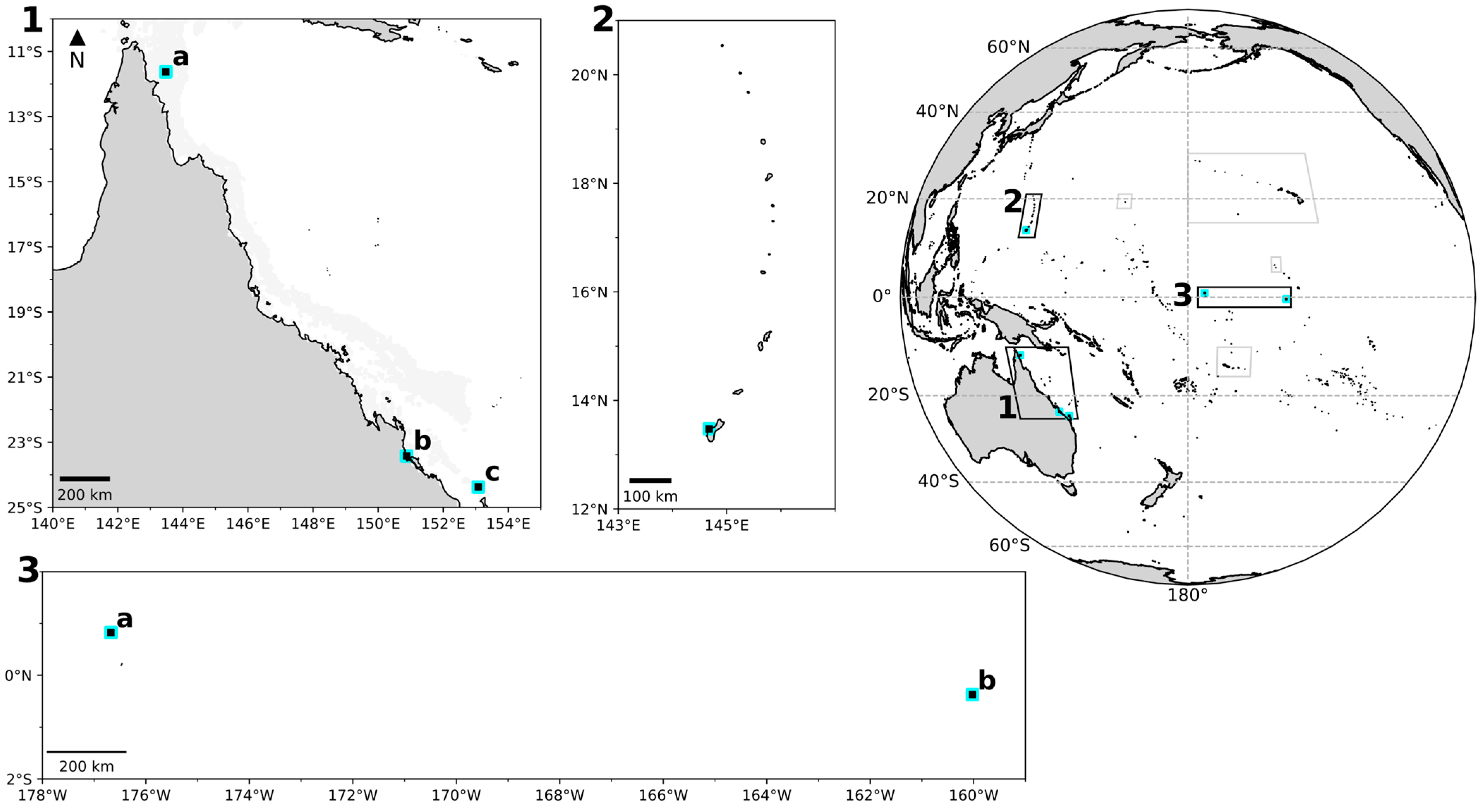
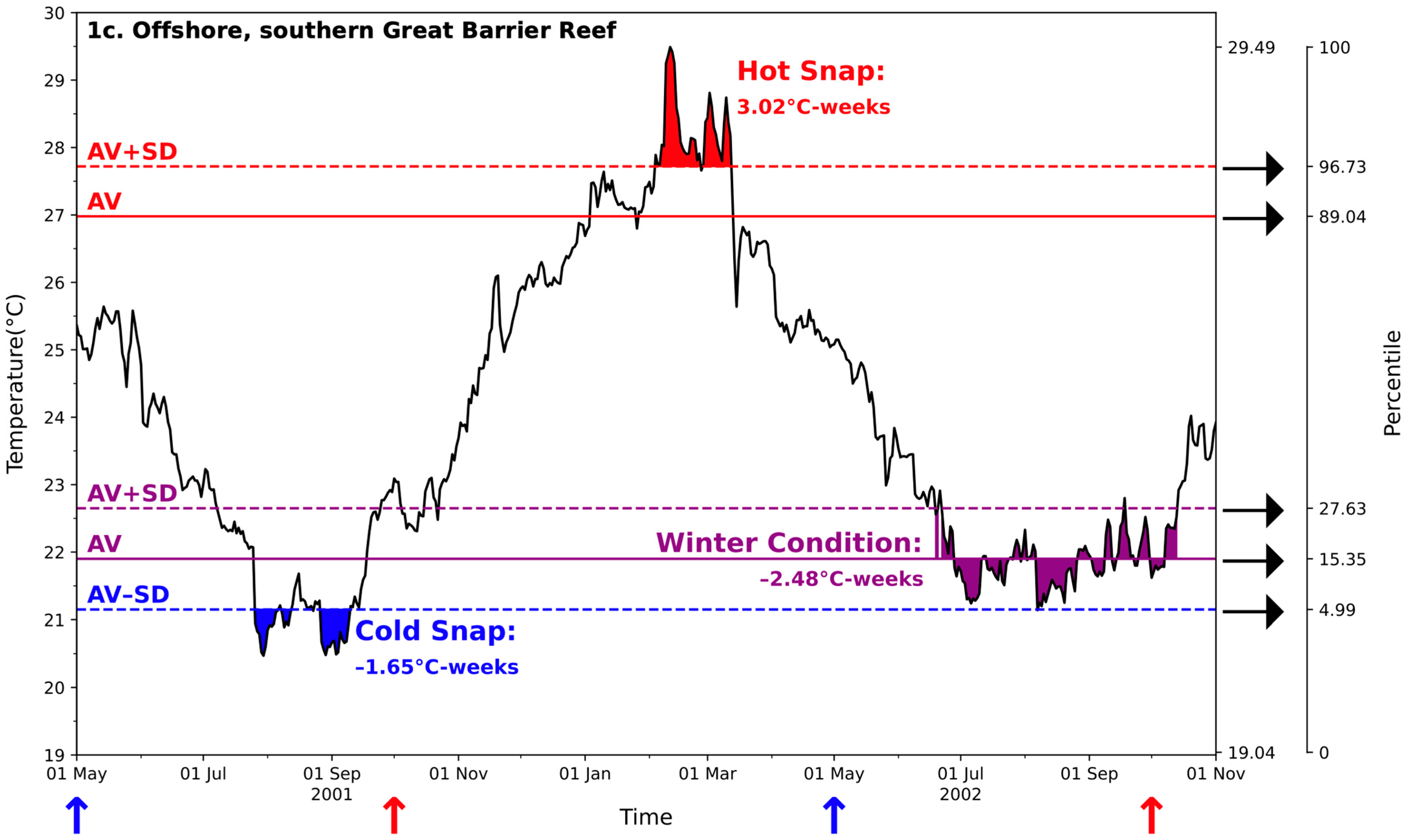
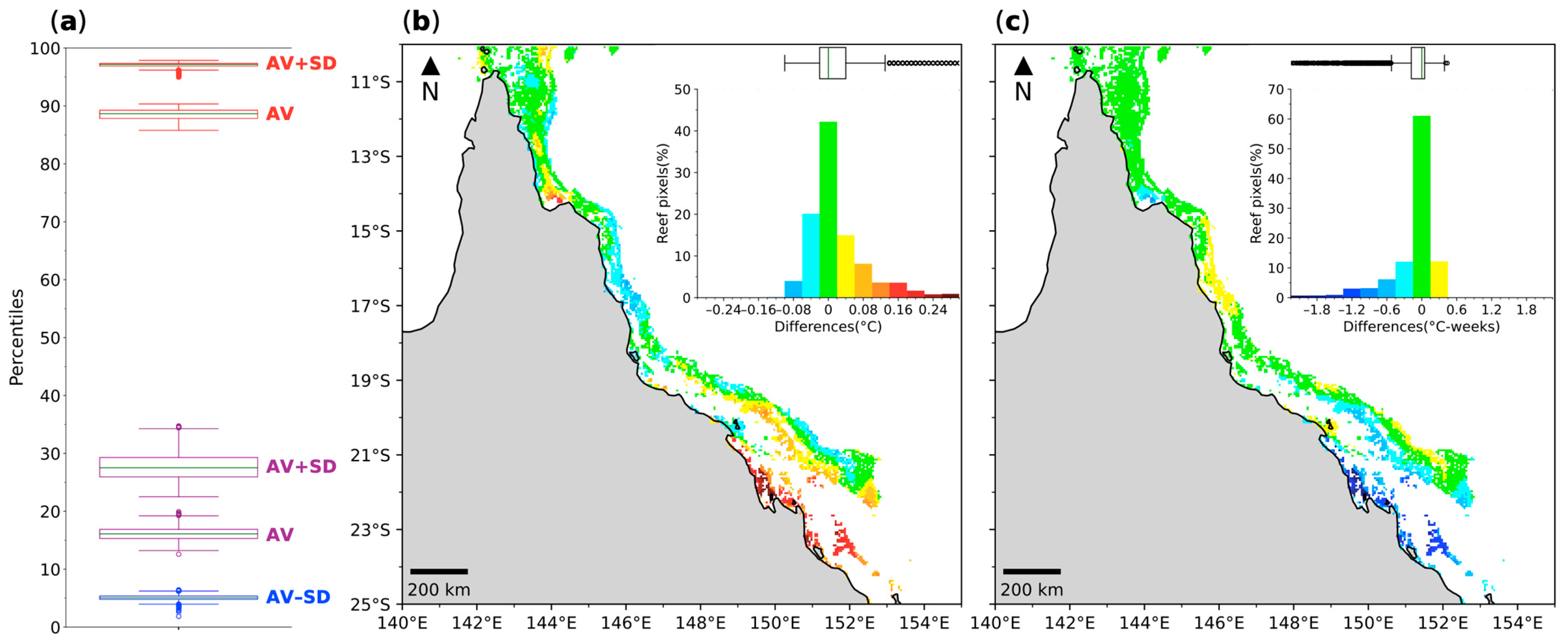
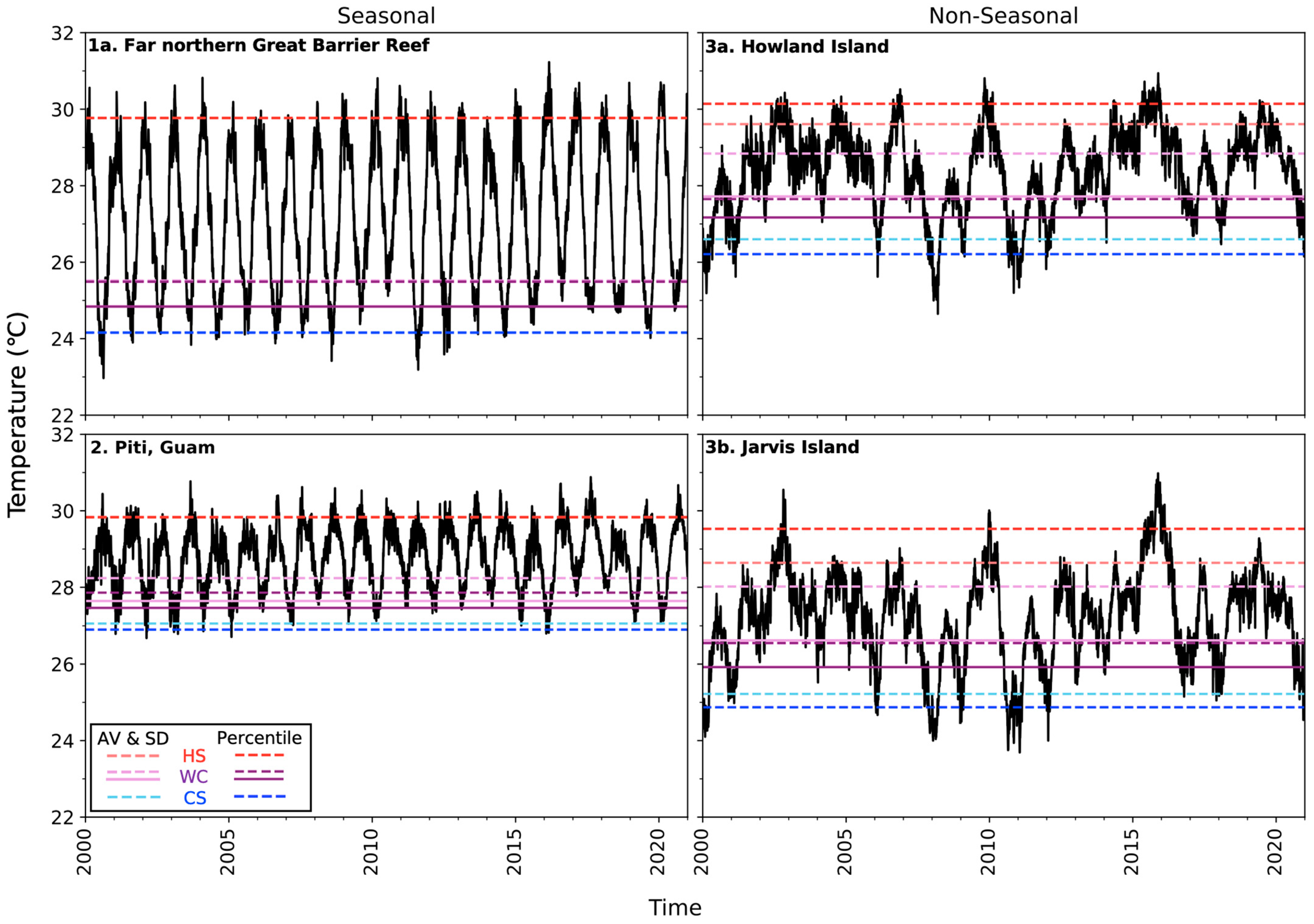
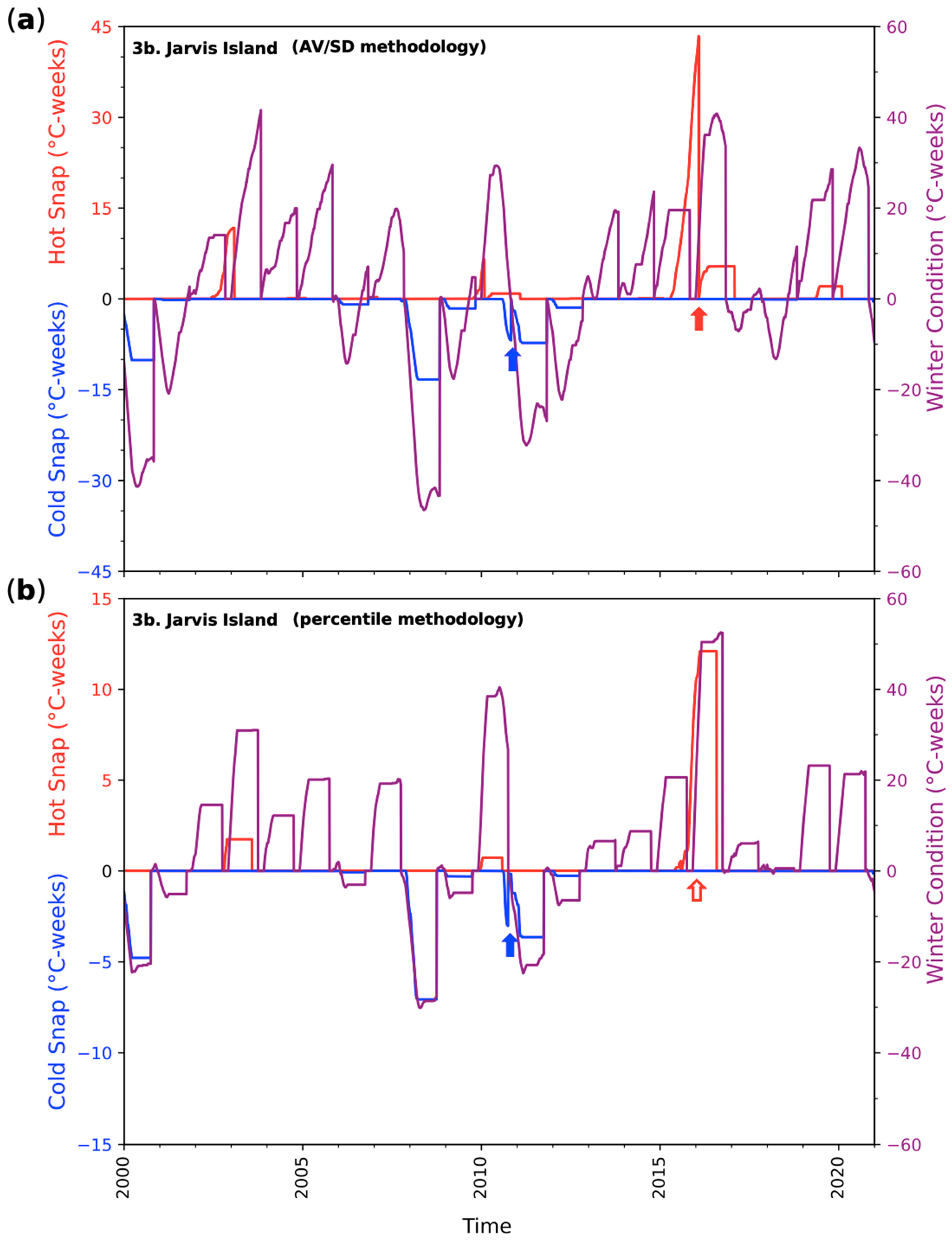
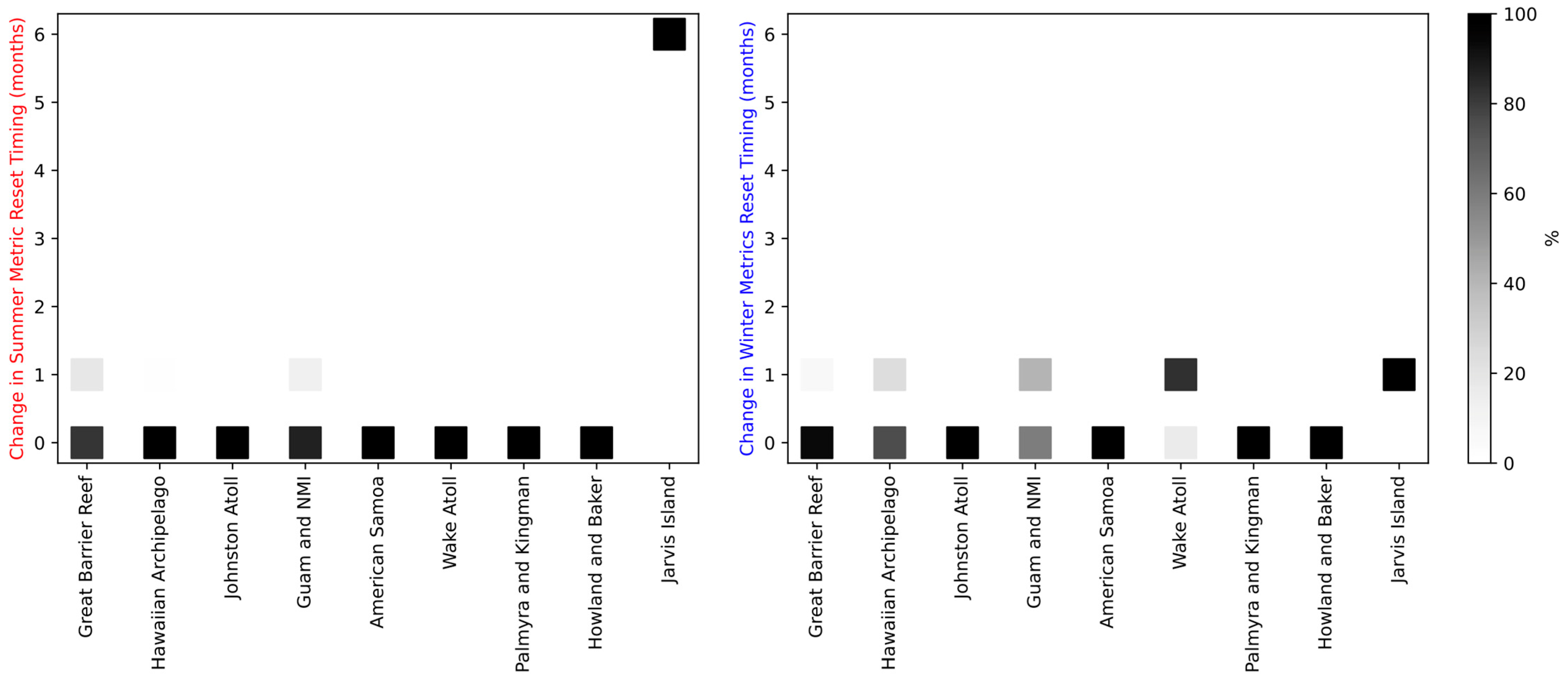
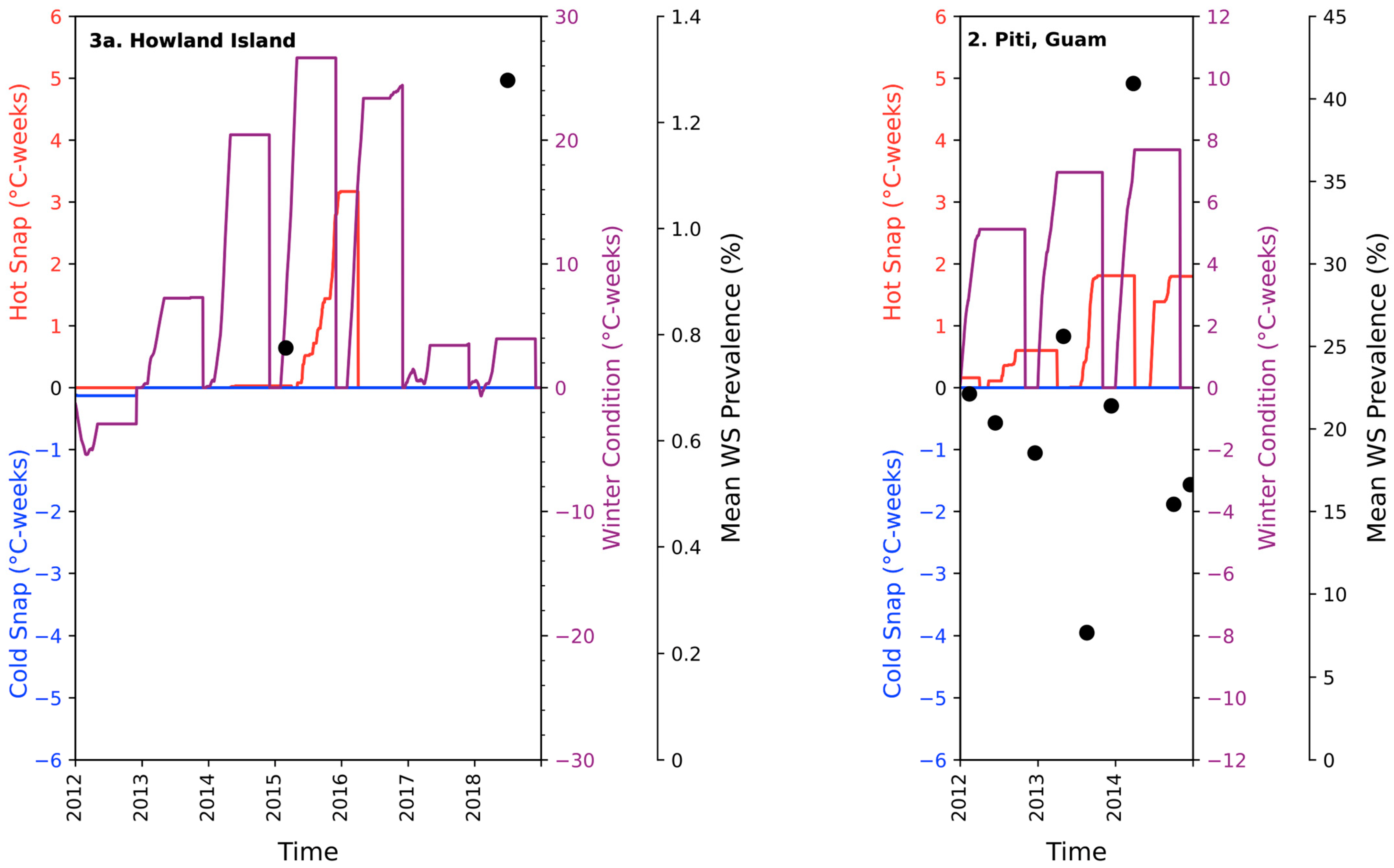
Disclaimer/Publisher’s Note: The statements, opinions and data contained in all publications are solely those of the individual author(s) and contributor(s) and not of MDPI and/or the editor(s). MDPI and/or the editor(s) disclaim responsibility for any injury to people or property resulting from any ideas, methods, instructions or products referred to in the content. |
© 2025 by the authors. Licensee MDPI, Basel, Switzerland. This article is an open access article distributed under the terms and conditions of the Creative Commons Attribution (CC BY) license (https://creativecommons.org/licenses/by/4.0/).
Share and Cite
Yoshida, M.; Heron, S.F. Extending Satellite Predictions of Coral Disease Outbreak Risk to Non-Seasonal Coral Reef Regions. Remote Sens. 2025, 17, 262. https://doi.org/10.3390/rs17020262
Yoshida M, Heron SF. Extending Satellite Predictions of Coral Disease Outbreak Risk to Non-Seasonal Coral Reef Regions. Remote Sensing. 2025; 17(2):262. https://doi.org/10.3390/rs17020262
Chicago/Turabian StyleYoshida, Momoe, and Scott F. Heron. 2025. "Extending Satellite Predictions of Coral Disease Outbreak Risk to Non-Seasonal Coral Reef Regions" Remote Sensing 17, no. 2: 262. https://doi.org/10.3390/rs17020262
APA StyleYoshida, M., & Heron, S. F. (2025). Extending Satellite Predictions of Coral Disease Outbreak Risk to Non-Seasonal Coral Reef Regions. Remote Sensing, 17(2), 262. https://doi.org/10.3390/rs17020262







